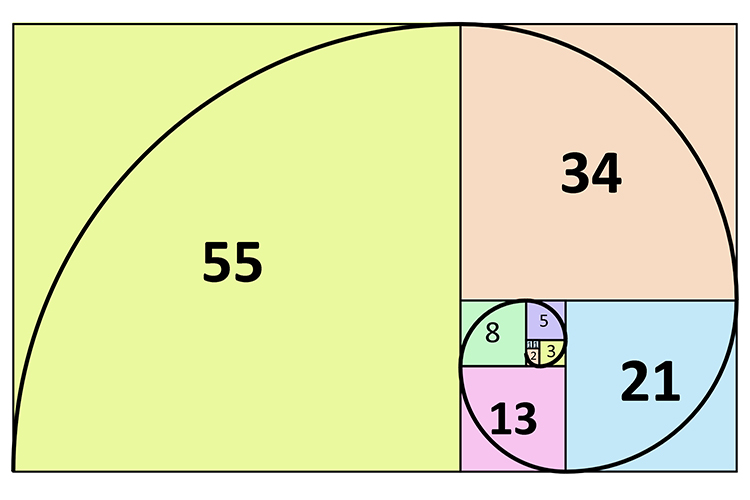
If you could explain the existence of the Pythagorean comma by way of phi, then you’d really have something going.Īlready mentioned a bit in the comments above though not totally, but the golden ratio follows automatically if you make a scale of harmonic positions on a string like is done in the bottom of this picture.
#FIBONACCI SEQUENCE NUMBERS SERIES#
Also, the perfect fourth and major sixth (12th overtone isn’t quite major) don’t appear naturally in the overtone series - at least, not until the partials are very close. I suspect you may be onto something with the relationship of phi to ratios within the harmonic series, but a proof of such a phenomenon would require much more than you’ve provided. Those half-steps aren’t really a direct result of the overtone series, they result from the 12th-root of 2 (2^(1/12)), the 2 representing the octave overtone and the 12 being the number of half-steps needed to fit in one octave… so the equally tempered half-steps you’re treating as similarly natural to the overtone series are actually produced by an equation designed by humans. Well… if you’re using the overtone series as your natural guidepost, which I fully advocate, it doesn’t make much sense to then switch to equally tempered half-steps. Insight on Fibonacci relationship to dominant 5th in major scale contributed by Sheila Yurick.ĭo you know of other examples of the golden ratio in music? Submit them below. Musical instrument design is often based on phi, the golden ratioįibonacci and phi are used in the design of violins and even in the design of high quality speaker wire. In a 32 bar song, this would occur in the 20th bar. As an example, the climax of songs is often found at roughly the phi point (61.8%) of the song, as opposed to the middle or end of the song.
:max_bytes(150000):strip_icc()/__opt__aboutcom__coeus__resources__content_migration__mnn__images__2012__10__Fibonacci_Golden-Ratio_Nature-de28a25e595f4fb8866b0e04755ce34a.jpg)
Musical compositions often reflect Fibonacci numbers and phiįibonacci and phi relationships are often found in the timing of musical compositions. The controversy over tuning still rages, with proponents of A432 or C256 as being more natural tunings than the current standard. A432 was often used by classical composers and results in a tuning of the whole number frequencies that are connected to numbers used in the construction of a variety of ancient works and sacred sites, such as the Great Pyramid of Egypt. It has been suggested by James Furia and others that A432 be the standard. Before recent times a variety of tunings were used. government its standard in 1920 and it was not until 1939 that this pitch was accepted internationally. The American Federation of Musicians accepted the A440 as standard pitch in 1917. Pluck a string on a guitar, however, and search for the harmonics by lightly touching the string without making it touch the frets and you will find pure Fibonacci relationships. In practice, pianos are tuned to a “tempered” frequency, a man-made adaptation devised to provide improved tonality when playing in various keys. The calculated frequency above starts with A440 and applies the Fibonacci relationships. This creates the Fibonacci ratios of 1:1, 2:3, 3:5, 5:8 and 8:13: The Fibonacci numbers, in red on both scales, fall on the same keys in both methods (C, D, E, G and C). Next, number the 13 notes of the chromatic scale.

Here’s another view of the Fibonacci relationship presented by Gerben Schwab in his YouTube video. First, number the 8 notes of the octave scale. This is analogous to the “A is to B as B is to C” basis for the golden section, or in this case “D is to A as A is to E.” What’s more, the typical three chord song in the key of A is made up of A, its Fibonacci & phi partner E, and D, to which A bears the same relationship as E does to A. This provides an added instance of Fibonacci numbers in key musical relationships. In a scale, the dominant note is the 5th note of the major scale, which is also the 8th note of all 13 notes that comprise the octave.

The word “octave” comes from the Latin word for 8, referring to the eight tones of the complete musical scale, which in the key of C are C-D-E-F-G-A-B-C. Note too how the piano keyboard scale of C to C above of 13 keys has 8 white keys and 5 black keys, split into groups of 3 and 2.While some might “note” that there are only 12 “notes” in the scale, if you don’t have a root and octave, a start and an end, you have no means of calculating the gradations in between, so this 13th note as the octave is essential to computing the frequencies of the other notes.


 0 kommentar(er)
0 kommentar(er)
